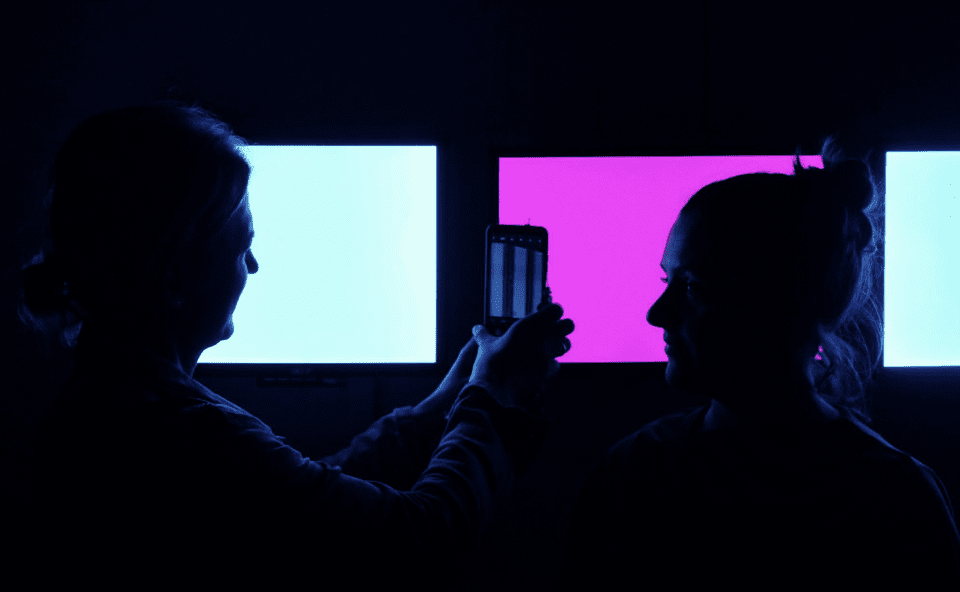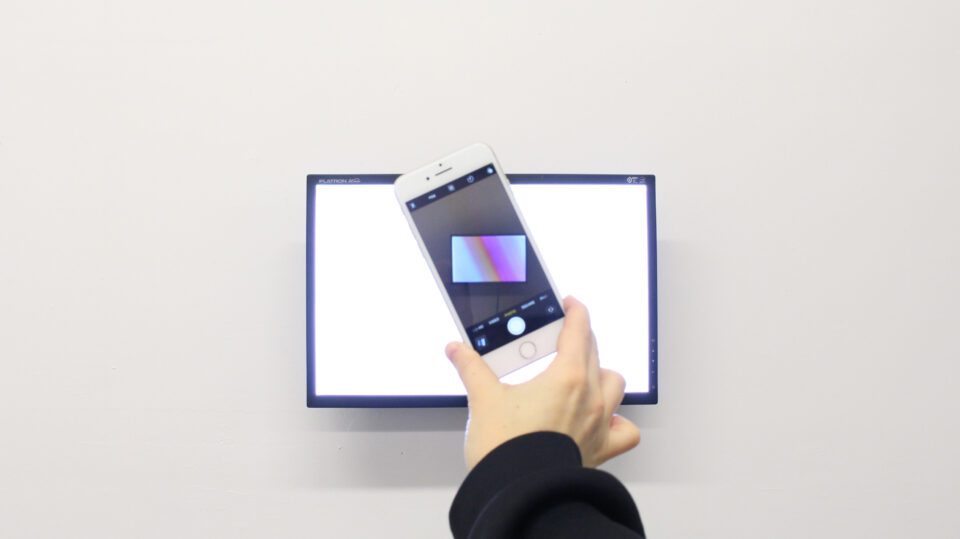Cinzia Campolese is an Italian-Canadian artist based in Tiohtià:ke/Montreal. She explores the perception of space in both digital and physical environments. The artist dissects technology, reintegrating objects into sculptural forms. Her shortlisted digital work Could you take a picture comments on how people document everyday moments in their lives. The piece showcases modified LCD screens from various brands and models. Instead of displaying content, each screen emits a full coloured light when looked at directly. The LED lighting system, typically used for visual content, is replaced with a custom one controlled by an integrated circuit. It creates patterns visible only through smartphone cameras, asking viewers to experience the work through another screen. Here, we speak to Campolese about her artwork, now showing amongst 20 shortlisted artists at the Aesthetica Art Prize Exhibition 2024 in York Art Gallery.

A: Could you take a picture? invites audiences to look through another screen to experience the work. Can you talk about the role of interactivity in the piece?
CC: As the title suggests, the artwork encourages action, and without that specific engagement, the work ceases to exist. Audiences can only access the content of the artwork through their phones. In my view, this is not a real interaction but a “passive” one. The work doesn’t actively engage with the user; instead, the interaction unfolds through the viewer’s engagement and vision. It relies on the viewer’s involvement. Through this piece, I wanted to comment on the role of interaction in art, particularly in contrast to what we see nowadays, with works using augmented reality. Whilst augmented reality reveals something previously hidden through a specific interface, my work follows a similar logic, with the act of being present and using another screen becoming the artwork itself, avoiding the need for an additional layer of reality.
A: What do you think is the relationship between technology and art?
CC: The connection between technology and art is like a mutual partnership – it’s symbiotic. Technology has significantly influced and improved artistic techniques. But, just like any relationship, it’s important to pause and consider how to create a meaningful connection that goes beyond just technique or accomplishments. We need to open up discourse. As artists, we need to learn the importance of taking time for ourselves to understand the implications of our work. Additionally, we should recognise that technology plays a dual role in art – it serves as a tool for expression, and a catalyst for contemplation.
A: How have you embedded sustainability into your practice?
CC: I try my best to incorporate sustainable practices into my work. This involves prioritising techniques that have minimal environmental impact, repurposing second-hand commodities and objects, giving them a renewed purpose. Could you take a picture specifically emerged from the intention of repurposing used, obsolete displays. It serves as a reminder of how we’ve become accustomed to living amidst technology that has a rapid expiration date, often not intended to have a second life.
A: Your work feels incredibly driven by perception. What topics are you drawn to most as an artist?
CC: I’m fascinated by how we perceive the world and the ways our interpretations shape our reality. I employ shapes, signs, objects, and spatial representations that may be familiar yet feel distant. This approach allows me to explore broader themes related to ontological representation and limitations. Lately, this exploration has led me to explore ideas about the impact of devices, investigating the concept of attention as a currency. I examine how constant surveillance affects us in our hyper-connected culture. As I navigate these themes, my process involves dismantling everyday technological objects – giving them a renewed layer of visibility, incorporating them into works that engage viewers with their surroundings.

A: How do you want viewers to feel after seeing Could you take a picture?
My primary goal is to challenge viewers to reconsider their relationship with technology. I want them to contemplate how it shapes their perceptions of the world. Most importantly, I want to offer visitors an opportunity to join in. The work is built as a mode of dialogue; it should spark curiosity and foster an appreciation for both magic and deception. I always try to create fleeting moments in my works, a brief instance that may last only seconds. During this moment, viewers form an initial impression of the work, only to witness a rapid transformation. This serves as a powerful reminder that nothing in reality is fixed, including our opinions, beliefs, and emotions — everything and nothing coexist simultaneously.
Campolese features in the Aesthetica Art Prize 2024 Exhibition at York Art Gallery from 16 February – 21 April. Plus, meet over 250 longlisted international artists in our new online gallery.
Want to get involved? The next edition of the Prize is open for entries. Submit your work by 31 August. Win £10,000, exhibition and publication. Find out more here.
Words: Chloe Elliott and Cinzia Campolese
All images courtesy Cinzia Campolese





